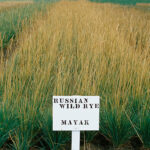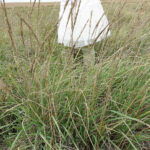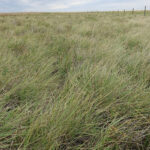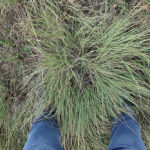Seigle sauvage russe
Psathyrostachys juncea
General Description
Russian wildrye is a large, cool season, introduced, long-lived, perennial bunchgrass. It is well suited for pasture and stockpiled grazing. The roots are fibrous and may establish to a depth of 1.9 to 2.6 m (6 to 8 ft.). However, about 75% of the roots are in the surface 15 to 60 cm (6 to 24 in.). Russian wildrye roots have an extended horizontal spread and may draw heavily on soil moisture for a distance of up to 1.3 to 1.6 m (4 to 5 ft.). Its long season of growth and its vigorous soil-feeding habit make this species an excellent competitor with weeds once the grass is well established.
Russian wildrye has an abundance of long, dense, basal leaves that are from 15 to 45 cm (6 to 18 in.) long and up to 0.6 cm (¼ in.) in width. Plants vary from light to dark green, with many shades of blue-green. The erect, leafless reproductive stems are about 75 to 100 cm (30 to 39 in.) tall.
Type
Tame grass.
Origin
Siberia. Varieties developed in Canada.
Longevity
At least 20 years.
Use
Pasture, stockpiled. A versatile forage for dryland pastures. The bulk of its forage production remains close to the ground, making it unsuitable for hay production.
Optimal Time of Use
Spring, fall, winter. Russian wildrye can be continually or rotationally grazed. Spring growth is somewhat later than crested wheatgrass. Basal growth allows for leaves to remain palatable into the later months.
Recovery After Use
Requires a minimum 60-80 days of recovery after use. After early spring grazing 8 to 10 cm (3-4 inches) will allow for regrowth ability. Fall regrowth is typically better than crested wheatgrass in the Brown soil zone.
Palatability/Nutritional Value
Most palatable in the spring and fall, Russian wildrye cures well on the stem and maintains good nutritional value into the winter making it useful as a stockpiled pasture forage. Its higher digestibility and wider season of use may compensate for a lower forage yield. Russian wildrye has an average digestibility of 66% and crude protein of 14% in the early summer.
Annual Precipitation min/max (mm)
200mm / 1150mm
Drought Tolerance
Excellent tolerance. Russian wildrye has excellent drought tolerance once established similar to crested wheatgrass.
Flooding Tolerance
Tolerates saturated soils for 1 week in the spring.
Winter Hardiness
Excellent hardiness.
Soil Texture Preference
Russian wildrye is best suited to loamy to heavy clays soils. If it can establish on a sandy site such as when it is sub-irrigated or there is a wet establishment year, Russian wildrye can be productive and long lived on coarse-textured soils.
Erosion Control
Russian wildrye is not suitable for erosion control.
Salinity Tolerance
High tolerance. Russian wildrye is one of the more saline tolerant grasses for drier sites.
Acidity Tolerance
Moderate tolerance.
Alkalinity Tolerance
High tolerance.
Seeds per kg
358,000 seeds/kg (162,000 seeds/lb)
Suggested Mixtures
Russian wildrye is unique in that it is a poor competitor while establishing and then out competes other species when established. Seeding Russian wildrye shallow and then seeding other species at 90 degrees (cross ways) can benefit all the species. Alfalfa, sainfoin or cicer milkvetch can complement Russian wildrye in a mix.
Ease of Establishment
Russian wildrye can be difficult to establish as seedlings are slow and not vigorous. Seed shallow. Allow one to two years for establishment before using. Control of weeds and competition from other plants before seeding and after seeding when possible.
Competitiveness
Russian wildrye is very competitive once established. Russian wildrye is a bunch grass that does not spread outwards. Despite not spreading it will out compete other species for moisture and nutrients as the stand ages.
Management Considerations
Although wide row spacings were recommended in the past, it is now a best practice to seed Russian wildrye at a normal row spacing (12 inch or less). Seeding with cover crops may decrease long term Russian Wildrye plant populations, but provide forage in the early years. Russian wildrye has a relatively low yield response to fertilizer.
content reference: British Columbia Rangeland Seeding Manual, Saskatchewan Dryland Forage Species Adaptation Tool, USDA Plants Database, Manitoba Forage Adaptation and Comparison Guide, Alberta Forage Manual
Russian wildrye is adapted to the drier parts of the Sub-Boreal Spruce and Sub-Boreal Pine–Spruce zones, and the Bunchgrass and Interior Douglas-fir zones in the southern part of the region.
Russian wildrye is best adapted to the drier zones in the region, i.e., the Bunchgrass, Ponderosa Pine and Interior Douglas-fir zones.
Russian wildrye is adapted to the Peace-Liard region, although it has not been widely used.



